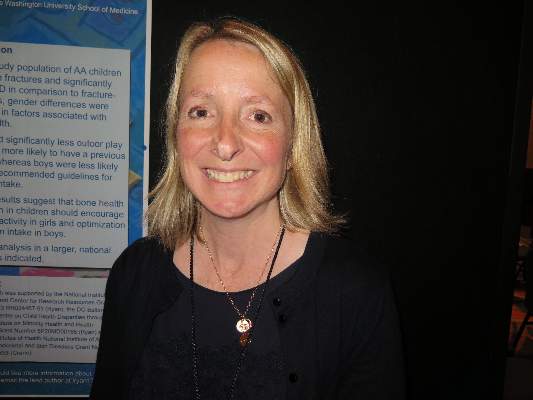User login
SAN DIEGO – Results from a study of children with forearm fractures found that girls had less outdoor play and were more likely to have a previous fracture, compared with boys, while boys were less likely to meet recommended guidelines for calcium intake.
“An increasing amount of research is demonstrating that children who have fractures, in particular forearm fractures, are demonstrating signs of poor bone health,” Dr. Leticia Manning Ryan said in an interview at the annual meeting of the American Academy of Pediatrics. “Prior studies have shown that kids with forearm fractures have lower bone mineral density and vitamin D deficiency, compared to children who don’t have fractures. Other studies have focused on Caucasian kids, and my work to date has focused on African American kids.”
In an effort to identify pertinent gender differences in children with a forearm fracture, help tailor prevention strategies, and promote bone health in childhood, Dr. Ryan and her associates prospectively evaluated 76 African American children with a forearm fracture and 74 age-matched controls without a fracture who were treated at Children’s National Medical Center, Washington. Measures of interest focused on the study population with fractures and included body mass index, dietary intake, outdoor play time, bone mineral density (BMD), and level of serum 25-hydroxyvitamin D. The researchers used descriptive statistics to evaluate gender differences in clinical characteristics that might affect bone health, including socioeconomic status, vitamin D concentration, BMD, mechanism of injury, history of prior fracture, level of physical activity, milk intake, and calcium intake.
Dr. Ryan and her associates found that a significantly higher proportion of girls had a prior fracture, compared with boys (21.9% vs. 4.5%; P = .04). Girls reported significantly less outdoor playing time per week, compared with boys (a mean of 13.6 vs. 18.3 hours; P = .004) and a higher proportion of outdoor playing time that lasted 1 hour or less per day (28.1% vs. 6.9%; P = .02).
“I was surprised that the girls were more likely to have a prior fracture, which is kind of a red flag in terms of a child who is potentially at risk for continuing to have fractures moving forward through life,” said Dr. Ryan, who is a pediatric emergency medicine physician at Johns Hopkins Children’s Center, Baltimore.
She and her associates also found that boys were significantly less likely than girls to meet the 2010 Recommended Dietary Allowance for calcium intake (19% vs. 40.6%; P = .04).
“If your child has a fracture, I think it’s important to take a step back to consider whether or not they are doing everything they can to build strong bones during childhood,” Dr. Ryan said. “That includes getting safe but good weight-bearing exercise, making sure that they’re meeting calcium intake, and checking to make sure that their vitamin D levels are normal, especially in a child who has had more than one fracture.”
Although the study was limited to African American children, she expects that the findings would apply to children from other ethnicities. “There is more that we need to be doing during childhood to build strong bones, as kids reach their peak bone mass around age 18,” she concluded.
The study was supported by the National Center for Research Resources, the D.C.-Baltimore Research Center on Child Health Disparities through the National Institute on Minority Health and Health Disparities, and the National Institute of Arthritis and Musculoskeletal and Skin Diseases. Dr. Ryan reported having no financial disclosures.
On Twitter @dougbrunk
SAN DIEGO – Results from a study of children with forearm fractures found that girls had less outdoor play and were more likely to have a previous fracture, compared with boys, while boys were less likely to meet recommended guidelines for calcium intake.
“An increasing amount of research is demonstrating that children who have fractures, in particular forearm fractures, are demonstrating signs of poor bone health,” Dr. Leticia Manning Ryan said in an interview at the annual meeting of the American Academy of Pediatrics. “Prior studies have shown that kids with forearm fractures have lower bone mineral density and vitamin D deficiency, compared to children who don’t have fractures. Other studies have focused on Caucasian kids, and my work to date has focused on African American kids.”
In an effort to identify pertinent gender differences in children with a forearm fracture, help tailor prevention strategies, and promote bone health in childhood, Dr. Ryan and her associates prospectively evaluated 76 African American children with a forearm fracture and 74 age-matched controls without a fracture who were treated at Children’s National Medical Center, Washington. Measures of interest focused on the study population with fractures and included body mass index, dietary intake, outdoor play time, bone mineral density (BMD), and level of serum 25-hydroxyvitamin D. The researchers used descriptive statistics to evaluate gender differences in clinical characteristics that might affect bone health, including socioeconomic status, vitamin D concentration, BMD, mechanism of injury, history of prior fracture, level of physical activity, milk intake, and calcium intake.
Dr. Ryan and her associates found that a significantly higher proportion of girls had a prior fracture, compared with boys (21.9% vs. 4.5%; P = .04). Girls reported significantly less outdoor playing time per week, compared with boys (a mean of 13.6 vs. 18.3 hours; P = .004) and a higher proportion of outdoor playing time that lasted 1 hour or less per day (28.1% vs. 6.9%; P = .02).
“I was surprised that the girls were more likely to have a prior fracture, which is kind of a red flag in terms of a child who is potentially at risk for continuing to have fractures moving forward through life,” said Dr. Ryan, who is a pediatric emergency medicine physician at Johns Hopkins Children’s Center, Baltimore.
She and her associates also found that boys were significantly less likely than girls to meet the 2010 Recommended Dietary Allowance for calcium intake (19% vs. 40.6%; P = .04).
“If your child has a fracture, I think it’s important to take a step back to consider whether or not they are doing everything they can to build strong bones during childhood,” Dr. Ryan said. “That includes getting safe but good weight-bearing exercise, making sure that they’re meeting calcium intake, and checking to make sure that their vitamin D levels are normal, especially in a child who has had more than one fracture.”
Although the study was limited to African American children, she expects that the findings would apply to children from other ethnicities. “There is more that we need to be doing during childhood to build strong bones, as kids reach their peak bone mass around age 18,” she concluded.
The study was supported by the National Center for Research Resources, the D.C.-Baltimore Research Center on Child Health Disparities through the National Institute on Minority Health and Health Disparities, and the National Institute of Arthritis and Musculoskeletal and Skin Diseases. Dr. Ryan reported having no financial disclosures.
On Twitter @dougbrunk
SAN DIEGO – Results from a study of children with forearm fractures found that girls had less outdoor play and were more likely to have a previous fracture, compared with boys, while boys were less likely to meet recommended guidelines for calcium intake.
“An increasing amount of research is demonstrating that children who have fractures, in particular forearm fractures, are demonstrating signs of poor bone health,” Dr. Leticia Manning Ryan said in an interview at the annual meeting of the American Academy of Pediatrics. “Prior studies have shown that kids with forearm fractures have lower bone mineral density and vitamin D deficiency, compared to children who don’t have fractures. Other studies have focused on Caucasian kids, and my work to date has focused on African American kids.”
In an effort to identify pertinent gender differences in children with a forearm fracture, help tailor prevention strategies, and promote bone health in childhood, Dr. Ryan and her associates prospectively evaluated 76 African American children with a forearm fracture and 74 age-matched controls without a fracture who were treated at Children’s National Medical Center, Washington. Measures of interest focused on the study population with fractures and included body mass index, dietary intake, outdoor play time, bone mineral density (BMD), and level of serum 25-hydroxyvitamin D. The researchers used descriptive statistics to evaluate gender differences in clinical characteristics that might affect bone health, including socioeconomic status, vitamin D concentration, BMD, mechanism of injury, history of prior fracture, level of physical activity, milk intake, and calcium intake.
Dr. Ryan and her associates found that a significantly higher proportion of girls had a prior fracture, compared with boys (21.9% vs. 4.5%; P = .04). Girls reported significantly less outdoor playing time per week, compared with boys (a mean of 13.6 vs. 18.3 hours; P = .004) and a higher proportion of outdoor playing time that lasted 1 hour or less per day (28.1% vs. 6.9%; P = .02).
“I was surprised that the girls were more likely to have a prior fracture, which is kind of a red flag in terms of a child who is potentially at risk for continuing to have fractures moving forward through life,” said Dr. Ryan, who is a pediatric emergency medicine physician at Johns Hopkins Children’s Center, Baltimore.
She and her associates also found that boys were significantly less likely than girls to meet the 2010 Recommended Dietary Allowance for calcium intake (19% vs. 40.6%; P = .04).
“If your child has a fracture, I think it’s important to take a step back to consider whether or not they are doing everything they can to build strong bones during childhood,” Dr. Ryan said. “That includes getting safe but good weight-bearing exercise, making sure that they’re meeting calcium intake, and checking to make sure that their vitamin D levels are normal, especially in a child who has had more than one fracture.”
Although the study was limited to African American children, she expects that the findings would apply to children from other ethnicities. “There is more that we need to be doing during childhood to build strong bones, as kids reach their peak bone mass around age 18,” she concluded.
The study was supported by the National Center for Research Resources, the D.C.-Baltimore Research Center on Child Health Disparities through the National Institute on Minority Health and Health Disparities, and the National Institute of Arthritis and Musculoskeletal and Skin Diseases. Dr. Ryan reported having no financial disclosures.
On Twitter @dougbrunk
AT THE AAP NATIONAL CONFERENCE
Key clinical point: Bone health promotion in children should encourage physical activity in girls and optimization of calcium intake in boys.
Major finding: A significantly higher proportion of girls had a prior fracture, compared with boys (21.9% vs. 4.5%; P = .04), while boys were significantly less likely than girls to meet the 2010 Recommended Dietary Allowance for calcium intake (19% vs. 40.6%; P = .04).
Data source: A prospective evaluation of 76 African American children with a forearm fracture and 74 age-matched controls without a fracture who were treated at Children’s National Medical Center, Washington.
Disclosures: The study was supported by the National Center for Research Resources, the D.C.-Baltimore Research Center on Child Health Disparities through the National Institute on Minority Health and Health Disparities, and the National Institute of Arthritis and Musculoskeletal and Skin Diseases. Dr. Ryan reported having no financial disclosures.

